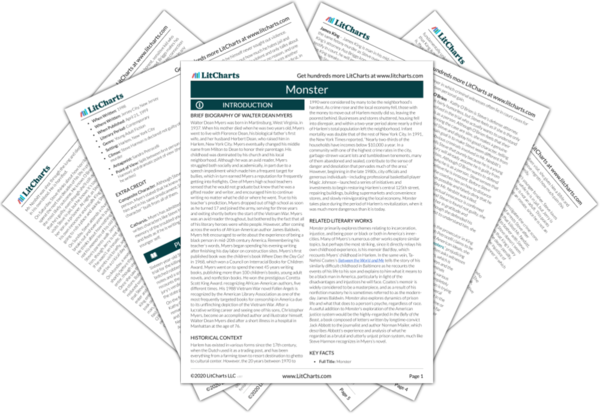Although Steve is a sensitive person with seemingly no inclination to violence, he is being tried for a violent crime, and he’s placed in a violent prison to await his sentencing. Non-violent Steve is thus thrust into violent environments and scenarios, demonstrating the manner in which Harlem’s violence absorbs even those who have no wish to participate in it. The novel’s depiction of both the streets of Harlem and the prison suggests that violence in inner city communities in the 1990s is an epidemic that’s seemingly unavoidable, even for well-meaning kids such as Steve.
Witness testimonies and Steve’s memories of his neighborhood depict an environment where violence is commonplace. Fourteen-year-old Osvaldo admits on the stand to being a member of the violent Diablos gang, which only lets members join after they’ve fought at least one member of the gang and slashed a random stranger’s face with a knife. This suggests that, in Harlem, kids are often pulled into violence at a very young age. It also that that endemic violence affects people who have no wish to be involved, such as the strangers who get their faces cut. Even for young kids not involved in gangs, violence seems unavoidable and a normal response to being hurt. When Steve and his friend Tony are twelve, for instance, Steve is practicing throwing rocks at a lamppost when he accidentally strikes a young woman. It doesn’t seriously injure her, but her adult boyfriend comes over and beats up Tony, who he thinks threw the rock. After the man leaves, Tony tells Steve he wants to “get […] an Uzi and blow his brains out.” Steve’s descriptions of Harlem are full of these casual threats and violent acts, suggesting that violence is common and unavoidable where Steve lives.
Steve’s observations of his brief time in prison suggest that it is an even more violent place than Harlem. At night, he can hear other prisoners being beaten and gang-raped. Just before lunch one day he sees one prisoner stab another one in the eye and keep beating him, even after the man is on the ground screaming. Far from being a place where violent criminals are rehabilitated to become better citizens, Steve’s experience of prison suggests that it actually makes men more fearful and violent than they once were. In his notes, Steve reflects, “Violence in [prison] is always happening or just about ready to happen. I think these guys like it—they want it to be normal because that’s what they’re used to dealing with.” This hints at the cycle of violence that encompasses the prison and Harlem alike: violent communities make violence seem normal, which leads people to criminal acts for which they’re imprisoned, and then they perpetuate violence in prison so that prison feels more like home, which means that they return home even more violent than they were—and the cycle repeats.
Steve’s fear and the passive manner in which he is implicated in Bobo and King’s violent crime suggests that even good kids like Steve often get sucked into the cycles of epidemic violence that plagued Harlem in the 1990s. During his court case, Steve privately recounts how he once looked up to King because he seemed tough and untouchable (or safe from the violence around him), suggesting that Steve’s own fear of violence caused him to admire a violent person. Although Steve never explicitly confirms his role in the robbery—and is acquitted of the murder charge—his inner narrative implies that he did check the store for cops before Bobo and King went in. However, his recollection of King’s enlisting him in the scheme depicts Steve himself as a passive participant, inadvertently roped into the plan by the much older King. By Steve’s recollection, he never wanted to take part in a robbery and only participated in the most passive way possible, simply walking into the store, looking around, and walking back out. Steve’s fear of violence leads to his respect for King, who ultimately implicates him in a violent act. The fact that Steve is only a teenager and never himself commits nor desires to commit a violent action, yet still is drawn into Harlem’s epidemic of violence, demonstrates how many young people in such inner-city neighborhoods are drawn into their community’s violence simply by being present.
Endemic Violence ThemeTracker

Endemic Violence Quotes in Monster
Prologue Quotes
The best time to cry is at night, when the lights are out and someone is being beaten up and screaming for help. That way if you sniffle a little they won’t hear you. If anybody knows that you are crying, they’ll start talking about it and soon it’ll be your turn to get beat up when the lights go out.
Thursday, July 9th Quotes
King curled his lip and narrowed his eyes. What was he going to do, scare me? All of a sudden he looked funny. All the times I had looked at him and wanted to be tough like him, and now I saw him sitting in handcuffs and trying to scare me. How could he scare me? I go to bed every night terrified out of my mind.
Saturday, July 11th Quotes
There was a fight just before lunch and a guy was stabbed in the eye. The guy who was stabbed was screaming, but that didn’t stop the other guy from hitting him more. Violence here is always happening or just about ready to happen. I think these guys like it—they want it to be normal because that’s what they’re used to dealing with.
Sunday, July 12th Quotes
I think I finally understand why there are so many fights. In here all you have going for you is the little surface stuff, how people look at you and what they say. And if that’s all you have, then you have to protect that. Maybe that’s right.











